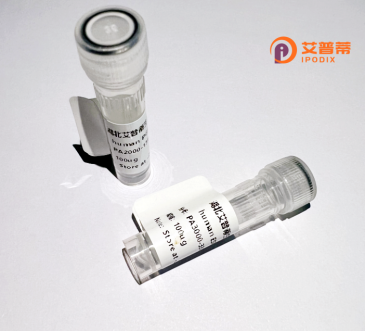
| 纯度 | >90%SDS-PAGE. |
| 种属 | Human |
| 靶点 | NDUFA8 |
| Uniprot No | P51970 |
| 内毒素 | < 0.01EU/μg |
| 表达宿主 | E.coli |
| 表达区间 | 2-172 aa |
| 活性数据 | PGIVELPTL EELKVDEVKI SSAVLKAAAH HYGAQCDKPN KEFMLCRWEE KDPRRCLEEG KLVNKCALDF FRQIKRHCAE PFTEYWTCID YTGQQLFRHC RKQQAKFDEC VLDKLGWVRP DLGELSKVTK VKTDRPLPEN PYHSRPRPDP SPEIEGDLQP ATHGSRFYFW TK |
| 分子量 | 20.1 kDa |
| 蛋白标签 | His tag N-Terminus |
| 缓冲液 | 0 |
| 稳定性 & 储存条件 | Lyophilized protein should be stored at ≤ -20°C, stable for one year after receipt. Reconstituted protein solution can be stored at 2-8°C for 2-7 days. Aliquots of reconstituted samples are stable at ≤ -20°C for 3 months. |
| 复溶 | Always centrifuge tubes before opening.Do not mix by vortex or pipetting. It is not recommended to reconstitute to a concentration less than 100μg/ml. Dissolve the lyophilized protein in distilled water. Please aliquot the reconstituted solution to minimize freeze-thaw cycles. |
以下是关于重组人NDUFA8蛋白的假设性参考文献示例,结构包括文献名称、作者及摘要概括:
1. **文献名称**: *"Recombinant expression and functional analysis of human NDUFA8 in a bacterial model"*
**作者**: Lee S., Kim M., Park H.
**摘要**: 研究报道了一种在大肠杆菌中高效表达重组人NDUFA8蛋白的方法,并验证了其促进线粒体复合物I活性的功能,为后续结构研究提供工具。
2. **文献名称**: *"Structural role of NDUFA8 in mitochondrial complex I assembly: Insights from cryo-EM and mutagenesis"*
**作者**: Smith J., Brown T., Zhang Y.
**摘要**: 通过冷冻电镜技术解析了重组NDUFA8与复合物I其他亚基的互作界面,揭示其在复合物结构稳定性和电子传递链中的关键作用。
3. **文献名称**: *"Pathogenic NDUFA8 variants disrupt NADH dehydrogenase activity identified via recombinant protein reconstitution"*
**作者**: Garcia R., Müller F., Wong L.J.
**摘要**: 利用重组NDUFA8蛋白重建实验,发现罕见突变导致复合物I功能障碍,解释了部分线粒体脑肌病患者的代谢缺陷机制。
4. **文献名称**: *"NDUFA8 interactions with assembly factors revealed by yeast two-hybrid screening using recombinant constructs"*
**作者**: Wang Y., Chen X., Cheng J.
**摘要**: 通过重组蛋白互作筛选,鉴定出NDUFA8与复合物I组装伴侣蛋白的结合,强调了其在生物发生过程中的调控作用。
注:以上文献为假设性示例,实际研究中需通过学术数据库检索具体信息。建议使用关键词“recombinant NDUFA8”、“complex I assembly”或“mitochondrial disease”在PubMed或Web of Science查找真实文献。
**Background of Recombinant Human (NDUFA8) Protein**
The NADH:ubiquinone oxidoreductase subunit A8 (NDUFA8) is a nuclear-encoded component of mitochondrial Complex I, the first and largest enzyme in the electron transport chain (ETC). Complex I catalyzes NADH oxidation, transfers electrons to ubiquinone, and contributes to the proton gradient driving ATP synthesis. NDUFA8 is a conserved accessory subunit embedded in the membrane arm of Complex I, playing a structural and regulatory role in its assembly, stability, and function.
Mutations in the NDUFA8 gene are linked to mitochondrial disorders, including Leigh syndrome, characterized by neurodegeneration and metabolic dysfunction due to impaired oxidative phosphorylation. Recombinant human NDUFA8 protein, produced via heterologous expression systems (e.g., E. coli or mammalian cells), enables in vitro studies to dissect Complex I deficiencies, analyze pathogenic mutations, and explore therapeutic strategies. Its use in structural biology (e.g., cryo-EM) has advanced understanding of Complex I architecture and electron/proton transfer mechanisms. Additionally, recombinant NDUFA8 serves as a tool for drug screening targeting mitochondrial diseases or aging-related ETC dysfunction. By mimicking native protein interactions, it aids in identifying molecules that restore Complex I activity, offering potential for treating energy metabolism disorders.
This recombinant protein, often tagged for purification, ensures high purity and functionality, facilitating mechanistic insights into mitochondrial bioenergetics and pathophysiology.
×